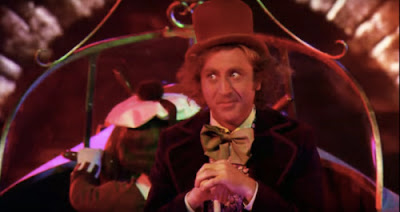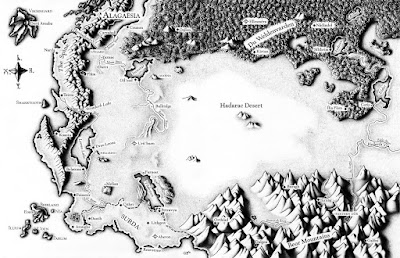Every successful story has a sense of direction. The audience wants, and even needs, an idea of where the story is going. If the audience literally has no idea what could happen next, then that often means what happens next doesn't really hold any value one way or another. It's like Willy Wonka's river ride into darkness--confusing, awkward, and a little bizarre. It's hard to trust Willy Wonka to get you anywhere. Writers should avoid being like Willy Wonka, for several reasons.
Wait! you may be thinking. Don't we want our stories to be unpredictable? Isn't not knowing where the story is going more exciting?
Many beginning writers make this mistake (including yours truly back in the day). They think having no clue where the story is going makes it more of a page-turner. They may recall audience members happily describing a story, saying, "I had no clue where it was going!" or "I had no idea what was going to happen next!"
These are just expressions of emotion. In reality, for the audience to even have those emotions, they usually must have a sense of direction first.
It's a similar concept to being vague versus being ambiguous. Vagueness happens when you don't have enough context to tell what something is, if anything. Ambiguity happens when there is enough context to interpret something in two or more ways, and you aren't sure which it is. When audiences say, "I had no clue where it was going," often what they really mean is, "I didn't know which of the critical directions it would go."
A story that has no sense of direction is almost never as effective as one that does. Without a sense of direction, the audience can't measure what is progress or what is a setback. They can't get invested, because they can't anticipate anything. They can't feel tension or suspense or even surprise, because they can't hope or fear for what could happen, and don't have expectations for what is going to happen.
Instead of Willy Wonka's tunnel of terror, imagine taking a hike toward a beautiful waterfall (it can still be made of chocolate if you want). A twisted ankle, closed trail, or nearby predator is a bigger setback than if we had nowhere we were trying to go. A shortcut is a bigger leap in progress if we are trying to reach a specific destination. And discovering we're actually on a trail that leads to an active volcano is a bigger surprise.
There are two critical plot elements that will automatically inject directionality into your story. Then, there are a lot of alternative methods you can use to reinforce it, or that you can rely on when performing a rule break (more on that in a bit). First, let's go over the two major ones:
1. Goals
A character's goal immediately gives the audience a sense of direction. This is because goals are about an outcome. They instantly convey what the character wants to happen, or doesn't want to happen. In order to be effective, though, they have to be achievable and relevant. Who cares if your character wants to do magic, if magic is literally impossible in your setting? That's not a real goal--it's a wish.
There are three basic types of goals: obtain, avoid, or maintain.
Convey a clear, relevant, and achievable goal early, and your audience will not only have a strong sense of direction, but they'll be more invested--because they'll want to see if the character gets the goal.
Then, if you add how the character plans to get the goal, you'll reinforce the goal and sense of direction even more.
2. Stakes
Many like to define stakes as what is at risk in the story. I feel like it's more effective and more accurate to define them as potential consequences. It's what could happen if a condition is met. If Voldemort gets the Sorcerer's Stone, then he can return to power. If Frodo destroys the Ring, then he saves Middle-earth. If Katniss cuts down the tracker jacker hive, then she can get away from the Careers.
As you may have noticed, stakes are often tied to goals. They are often the potential consequences of meeting or not meeting a goal.
Stakes are about conveying to the audience what could happen. This gives what does happen, meaning.
Stakes also innately convey a pathway, a direction. If X happens, we'll go down path A. If Y happens, we'll go down path B.
I've never seen a story with too many stakes. I've seen lots of stories that don't have enough stakes. Walk the stakes out to create strong directionality.
And don't assume your audience will simply imagine the stakes on their own. Almost always, they want the story to tell them (explicitly or implicitly) the stakes. Almost always, the story is better when we clearly communicate the stakes. Avoid being vague. Help the audience imagine which important pathways the story could take.
~
These are the two most important, and most effective, ways to create directionality--they accomplish multiple major things at once.
However, this doesn't mean they are the only ways to create directionality.
And while they are almost always critical to a solid plot, that doesn't mean you can't ever break the rules and have them be absent on occasion.
If they are absent though, that usually means something else needs to be used to create directionality in their place (unless, of course, you are working with a teaser--but even they can arguably have a sense of direction). So how do stories without legit goals or stakes still work? Well, they probably incorporate at least one of the following things--which you can also use to reinforce directionality when you already have goals and stakes in play.
~
3. Dramatic Irony
Dramatic irony happens when the audience knows something the character doesn't. Often this is a critical piece of information, and frequently (though not always) it is implied that the character will learn the same thing at a later point in the story. In a horror, we watch the villain enter a dark room, and later see the heroine, oblivious, go in that same room. It's likely only a matter of time before the heroine realizes the villain is in there, and the audience anticipates that encounter. This creates directionality.
Even if the character never learns the critical information (such as the fact that Juliet isn't actually dead in Romeo and Juliet), the audience still anticipates how the character will interpret or react to what they do encounter (a Juliet who seems to be dead).
4. Convergence of Plotlines
In a story that contains multiple viewpoint characters, each with plotlines, it's often implied or assumed that these plotlines and characters will converge. We may start a story with a rich man eating a feast for breakfast, then taking his recent earnings to the bank. And after, we may cut to a scene where a poor, starving woman is begging, perhaps a block away from the same bank. The audience anticipates that these two characters will cross paths.
Sometimes the two viewpoints or plotlines don't seem to have anything in common, but the audience expects they will relate to each other on some level--they are in the same book after all.
Promise your audience a collision of plotlines, and you'll promise them a sense of direction.
5. Countdowns
A countdown automatically implies direction--whether or not the audience knows the consequences tied to it. We show a clock counting down, and we wonder if a bomb will go off or if another catastrophe will hit once it reaches zero. Or, it could be a countdown to a celebration, like the New Year.
Countdowns on a timer are obvious, but there are other types of countdowns too. A simple calendar can work as a countdown. In Christmas Vacation, an advent calendar is used to count down the days until Christmas. Each Harry Potter volume fulfills one school year, each chapter brings us closer to the year's end. So even when there isn't a dire goal in play, there is always directionality.
A deadline works in similar ways.
There can be a countdown when using up resources: Fuel is running out. Oxygen is limited. There is only one loaf of bread left to eat.
Illnesses and maladies can work as countdowns. There may be a countdown to when cancer wins, or when a spell leaves its target as an unseemly beast, permanently.
Countdowns always imply direction.
Knowing the potential consequences--the stakes--creates more tension and suspense, not knowing them creates intrigue.
6. Geographical Destinations
A destination naturally implies direction. In The Emperor's New Groove, Kuzco needs to make it back to his palace. Every step closer is progress, and every obstacle that blocks or pulls him off course is a setback.
But destinations can still work even when there isn't one specific destination yet established. Whenever you open a book that starts with a map, it implies a sense of geographical direction. You may not know exactly which place is the desired destination, but the map promises that the characters will be venturing to different places.
7. Passive Mysteries
Passive mysteries work by withholding context from the audience. Stuff is happening, but the audience doesn't really know what it means (think: vagueness). Because of the lack of information, no one is really doing anything to solve the mystery--there aren't any "leads." (In contrast, in an active mystery, the character has the goal to solve the mystery and has leads to follow.)
Teasers often work as passive mysteries (which is why I said sometimes even they have a sense of direction). The audience is promised that if they stick around, they will get the context they need, to understand what is going on. The audience is promised a direction.
Passive mysteries often can't hold an audience for very long, strictly because they work off vagueness. You need other elements in play to get readers to stick around.
Nonetheless, the promise of context does give readers some sense of direction.
Active mysteries create directionality too, but in the same way that goals do. In an active mystery, the goal is to try to solve the mystery, so the audience is promised a direction with that.
Directionality is important in every story, and not only is it important in the whole narrative arc, but it is important within acts, sequences, and scenes, too. Nearly every scene should have directionality, which should be established early on.
Once the audience has directionality, you can make the story more exciting and dramatic (and even "unpredictable"). They think things are going X direction, but something comes along that threatens that direction or even throws the characters off course and onto a new pathway, a new direction. Just like our (chocolate) waterfall hike. In any case, there should almost always be a sense of direction.



























Great article! Very informative, took notes and will definitely think these techniques through as I work on my current novel. (And when I go back to older ones to revise.)
ReplyDeleteHey Sheri, thanks for stopping by! I'm so glad it was helpful--this is something I wish I understood better a long time ago, when I started taking writing seriously. Best wishes with your work.
Delete